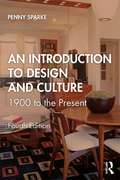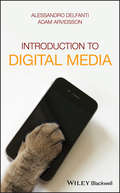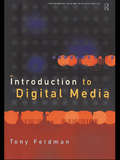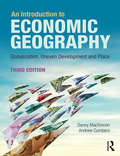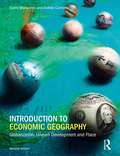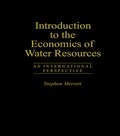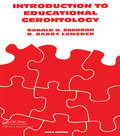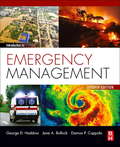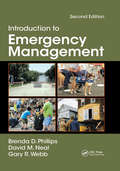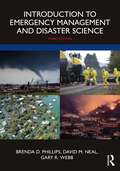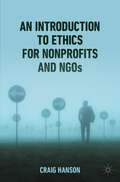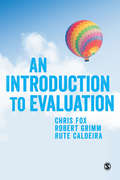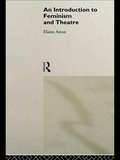- Table View
- List View
An Introduction to Design and Culture: 1900 to the Present
by Penny SparkeThis third edition of An Introduction to Design and Culture has been revised and updated throughout to include issues of globalization, sustainability and digital/interactive design. New for this edition is a chapter which covers key changes in design culture. Design culture has changed dramatically in the 21st century, the designer-hero is now much less in evidence and design has become much more interdisciplinary. Drawing on a wealth of mass-produced artefacts, images and environments including sewing machines, cars, televisions, clothes, electronic and branded goods and exhibitions, author Penny Sparke shows how design has helped to shape and reflect our social and cultural development. This introduction to the development of modern (and postmodern) design is ideal for undergraduate students.
An Introduction to Design and Culture: 1900 to the Present
by Penny SparkeThis third edition of An Introduction to Design and Culture has been revised and updated throughout to include issues of globalization, sustainability and digital/interactive design. New for this edition is a chapter which covers key changes in design culture. Design culture has changed dramatically in the 21st century, the designer-hero is now much less in evidence and design has become much more interdisciplinary. Drawing on a wealth of mass-produced artefacts, images and environments including sewing machines, cars, televisions, clothes, electronic and branded goods and exhibitions, author Penny Sparke shows how design has helped to shape and reflect our social and cultural development. This introduction to the development of modern (and postmodern) design is ideal for undergraduate students.
An Introduction to Design and Culture: 1900 to the Present
by Penny SparkeAn Introduction to Design and Culture provides a comprehensive guide to the changing relationships between design and culture from 1900 to the present day with an emphasis on five main themes: Design and consumption Design and technology The design profession Design theory Design and identities This fourth edition extends the traditional definition of design as covering product design, furniture design, interior design, fashion design and graphic design to embrace its more recent manifestations, which include service design, user-interface design, co-design, and sustainable design, among others. It also discusses the relationship between design and the new media and the effect of globalisation on design. Taking a broadly chronological approach, Professor Sparke employs historical methods to show how these themes developed through the twentieth century and into the twenty-first century and played a role within modernism, postmodernism and beyond. Over a hundred illustrations are used throughout to demonstrate the breadth of design and examples – among them design in Modern China, the work of Apple Computers Ltd., and design thinking – are used to elaborate key ideas. The new edition remains essential reading for undergraduate and postgraduate students of design studies, cultural studies and visual arts.
An Introduction to Design and Culture: 1900 to the Present
by Penny SparkeAn Introduction to Design and Culture provides a comprehensive guide to the changing relationships between design and culture from 1900 to the present day with an emphasis on five main themes: Design and consumption Design and technology The design profession Design theory Design and identities This fourth edition extends the traditional definition of design as covering product design, furniture design, interior design, fashion design and graphic design to embrace its more recent manifestations, which include service design, user-interface design, co-design, and sustainable design, among others. It also discusses the relationship between design and the new media and the effect of globalisation on design. Taking a broadly chronological approach, Professor Sparke employs historical methods to show how these themes developed through the twentieth century and into the twenty-first century and played a role within modernism, postmodernism and beyond. Over a hundred illustrations are used throughout to demonstrate the breadth of design and examples – among them design in Modern China, the work of Apple Computers Ltd., and design thinking – are used to elaborate key ideas. The new edition remains essential reading for undergraduate and postgraduate students of design studies, cultural studies and visual arts.
Introduction to Digital Media
by Alessandro Delfanti Adam ArvidssonNew and updated English translation of the highly successful book on digital media This book introduces readers to the vast and rich world of digital media. It provides a strong starting point for understanding digital media’s social and political significance to our culture and the culture of others—drawing on an emergent and increasingly rich set of empirical and theoretical studies on the role and development of digital media in contemporary societies. Touching on the core points behind the discipline, the book addresses a wide range of topics, including media economics, online cooperation, open source, social media, software production, globalization, brands, marketing, the cultural industry, labor, and consumption. Presented in six sections—Media and Digital Technologies; The Information Society; Cultures and Identities; Digital Collaboration; Public Sphere and Power; Digital Economies—the book offers in-depth chapter coverage of new and old media; network infrastructure; networked economy and globalization; the history of information technologies; the evolution of networks; sociality and digital media; media and identity; collaborative media; open source and innovation; politics and democracy; social movements; surveillance and control; digital capitalism; global inequalities and development; and more. Delivers a reliable, compact and quick introduction to the core issues analyzed by digital culture studies and sociology of information societies Interweaves main topics and theories with several examples and up-to-date case studies, often linked to our everyday lives on the internet, as well as suggestions for further readings Anchors examples to discussions of the main sociological, political, and anthropological theoretical approaches at stake to help students make sense of the changes brought about by digital media Uses critical sociological and political theory alongside every day examples to discuss concepts such as online sociality, digital labor, digital value creation, and the reputation economy Clear and concise throughout, Introduction to Digital Media is an excellent primer for those teaching and studying digital culture and media.
Introduction to Digital Media
by Alessandro Delfanti Adam ArvidssonNew and updated English translation of the highly successful book on digital media This book introduces readers to the vast and rich world of digital media. It provides a strong starting point for understanding digital media’s social and political significance to our culture and the culture of others—drawing on an emergent and increasingly rich set of empirical and theoretical studies on the role and development of digital media in contemporary societies. Touching on the core points behind the discipline, the book addresses a wide range of topics, including media economics, online cooperation, open source, social media, software production, globalization, brands, marketing, the cultural industry, labor, and consumption. Presented in six sections—Media and Digital Technologies; The Information Society; Cultures and Identities; Digital Collaboration; Public Sphere and Power; Digital Economies—the book offers in-depth chapter coverage of new and old media; network infrastructure; networked economy and globalization; the history of information technologies; the evolution of networks; sociality and digital media; media and identity; collaborative media; open source and innovation; politics and democracy; social movements; surveillance and control; digital capitalism; global inequalities and development; and more. Delivers a reliable, compact and quick introduction to the core issues analyzed by digital culture studies and sociology of information societies Interweaves main topics and theories with several examples and up-to-date case studies, often linked to our everyday lives on the internet, as well as suggestions for further readings Anchors examples to discussions of the main sociological, political, and anthropological theoretical approaches at stake to help students make sense of the changes brought about by digital media Uses critical sociological and political theory alongside every day examples to discuss concepts such as online sociality, digital labor, digital value creation, and the reputation economy Clear and concise throughout, Introduction to Digital Media is an excellent primer for those teaching and studying digital culture and media.
An Introduction to Digital Media
by Tony FeldmanIn this clear and highly accessible book, Tony Feldman provides an account of the evolution and application of digital media. Clarifying its underlying technologies, he identifies its immense commercial and human potential. Using as a starting point a simplification which considers new media in two distinct sectors; packaged 'off-line' media such as CD-ROMs; and the world of transmitted media which includes digital broadcasting and interactive online services, Feldman provides a comprehensive overview of the digital media landscape. Focusing on multimedia and the entertainment media he describes and analyses the spectacular rise of CD-based information and the equally revolutionary development of the Internet and online services. Set within a commercial context, readers can identify the potential to generate revenue and profit from the new media. An Introduction to Digital Media concludes with a strategic assessment of the implications of going digital for individuals, companies and corporations.
An Introduction to Digital Media
by Tony FeldmanIn this clear and highly accessible book, Tony Feldman provides an account of the evolution and application of digital media. Clarifying its underlying technologies, he identifies its immense commercial and human potential. Using as a starting point a simplification which considers new media in two distinct sectors; packaged 'off-line' media such as CD-ROMs; and the world of transmitted media which includes digital broadcasting and interactive online services, Feldman provides a comprehensive overview of the digital media landscape. Focusing on multimedia and the entertainment media he describes and analyses the spectacular rise of CD-based information and the equally revolutionary development of the Internet and online services. Set within a commercial context, readers can identify the potential to generate revenue and profit from the new media. An Introduction to Digital Media concludes with a strategic assessment of the implications of going digital for individuals, companies and corporations.
An Introduction to Economic Geography: Globalisation, Uneven Development and Place
by Andrew Cumbers Danny MacKinnonIn the context of great economic turmoil and uncertainty, the emergent conflict between continued globalisation and growing economic nationalism means that a geographical economic perspective has never been so important. An Introduction to Economic Geography guides students through the key debates of this vibrant area, exploring the range of ideas and approaches that invigorate the wider discipline. This third edition includes new chapters on finance, cities and the digital economy, consumption and the environment. Underpinned by the themes of globalisation, uneven development and place, the text conveys the diversity of contemporary economic geography and explores the social and spatial effects of global economic restructuring. It combines a critical geographical perspective on the changing economic landscape with an appreciation of contemporary themes such as neoliberalism, financialisation, innovation and the growth of new technologies. An Introduction to Economic Geography is an essential textbook for undergraduate students taking courses in Economic Geography, Globalisation Studies and more broadly in Human Geography. It will also be of much interest to those in Planning, Business and Management Studies and Economics.
Introduction to Economic Geography: Globalization, Uneven Development and Place
by Danny MacKinnon Andrew CumbersToday's rapidly flowing global economy, hit by recession following the financial crisis of 2008/9, means the geographical economic perspective has never been more important. An Introduction to Economic Geography comprehensively guides you through the core issues and debates of this vibrant and exciting area, whilst also exploring the range of approaches and paradigms currently invigorating the wider discipline. Rigorous and accessible, the authors demystify and enliven a crucial subject for geographical study. Underpinned by the themes of globalisation, uneven development and place, the text explores the diversity and vitality of contemporary economic geography. It balances coverage of 'traditional' areas such as regional development and labour markets with insight into new and evolving topics like neoliberalism, consumption, creativity and alternative economic practices. An Introduction to Economic Geography is an essential textbook for undergraduate students taking courses in Economic Geography, Globalisation Studies and more broadly in Human Geography. It will also be of key interest to anyone in Planning, Business and Management Studies and Economics.
Introduction to Economic Geography: Globalization, Uneven Development and Place
by Danny MacKinnon Andrew CumbersToday's rapidly flowing global economy, hit by recession following the financial crisis of 2008/9, means the geographical economic perspective has never been more important. An Introduction to Economic Geography comprehensively guides you through the core issues and debates of this vibrant and exciting area, whilst also exploring the range of approaches and paradigms currently invigorating the wider discipline. Rigorous and accessible, the authors demystify and enliven a crucial subject for geographical study. Underpinned by the themes of globalisation, uneven development and place, the text explores the diversity and vitality of contemporary economic geography. It balances coverage of 'traditional' areas such as regional development and labour markets with insight into new and evolving topics like neoliberalism, consumption, creativity and alternative economic practices. An Introduction to Economic Geography is an essential textbook for undergraduate students taking courses in Economic Geography, Globalisation Studies and more broadly in Human Geography. It will also be of key interest to anyone in Planning, Business and Management Studies and Economics.
Introduction To The Economics Of Water Resources: An International Perspective
by Stephen MerrettFirst published in 1997. Routledge is an imprint of Taylor & Francis, an informa company.
Introduction To The Economics Of Water Resources: An International Perspective
by Stephen MerrettFirst published in 1997. Routledge is an imprint of Taylor & Francis, an informa company.
Introduction to Educational Gerontology (Series in Death, Dying, and Bereavement)
by Ronald H. Sherron D. Barry LumsdenEducational gerontology is the study of the changes in the learning process caused by old age. This new edition provides an update of developments in this field of research. The volume probes topics such as implications for education for the aging, reminiscence, methods of teaching, social exchange and equal opportunity.
Introduction to Educational Gerontology (Series in Death, Dying, and Bereavement)
by Ronald H. Sherron D. Barry LumsdenEducational gerontology is the study of the changes in the learning process caused by old age. This new edition provides an update of developments in this field of research. The volume probes topics such as implications for education for the aging, reminiscence, methods of teaching, social exchange and equal opportunity.
Introduction to Emergency Management
by Damon P. Coppola Jane A. Bullock George D. HaddowIntroduction to Emergency Management, Seventh Edition, sets the standard for excellence in the field and has educated a generation of emergency managers. This long-trusted resource provides a broad overview of the key aspects of the emergency management profession. Readers will gain an understanding of why the emergency management profession exists, what actions its professionals and practitioners are tasked with performing, and what achievements are sought through the conduct of these various efforts. Students and new professionals alike will further gain an enhanced understanding of key terminology and concepts that enable them to work with emergency management specialists.Emphasizes climate change as a key hazard faced by disaster managersIncludes coverage of social media as a critical tool in emergency managementContains updated ancillaries, new examples, and case studies throughout
Introduction to Emergency Management
by Brenda Phillips David M. Neal Gary WebbEmergency management university programs have experienced dramatic and exponential growth over the last twelve years. This new, fully updated edition introduces majors and minors to the field and provides content accessible to those students taking introductory emergency management courses. The book’s student-centered focus looks at the regional, state, and local level response, as well as some of the often misunderstood or overlooked social aspects of disasters. Real-world cases are described throughout including considerations of international emergency management and disasters alongside features from former students now working as professionals in the field of emergency management.
Introduction to Emergency Management
by Brenda Phillips David M. Neal Gary WebbEmergency management university programs have experienced dramatic and exponential growth over the last twelve years. This new, fully updated edition introduces majors and minors to the field and provides content accessible to those students taking introductory emergency management courses. The book’s student-centered focus looks at the regional, state, and local level response, as well as some of the often misunderstood or overlooked social aspects of disasters. Real-world cases are described throughout including considerations of international emergency management and disasters alongside features from former students now working as professionals in the field of emergency management.
Introduction to Emergency Management and Disaster Science
by Brenda D. Phillips David M. Neal Gary R. WebbA definitive resource, the Introduction to Emergency Management and Disaster Science presents the essentials to better understand and manage disasters. The third edition of this popular text has been revised and updated to provide a substantively enriched and evidence-based guide for students and emerging professionals. The new emphasis on disaster science places it at the forefront of a rapidly evolving field. This third edition offers important updates, including: Newly commissioned insights from former students and professional colleagues involved with emergency management practice and disaster science; international policies, programs, and practices; and socially vulnerable populations. Significantly enriched content and coverage of new disasters and recent research, particularly the worldwide implications of climate change and pandemics. Pedagogical features like chapter objectives, key terms and definitions, discussion points and resources. The only textbook authored by three winners of the Blanchard Award for excellence in emergency management instruction. Online Support Material with instructional videos containing practical information and learning objectives for the next generation of emergency managers and disaster scientists. The Introduction to Emergency Management and Disaster Science is a must-have textbook for graduate and undergraduate students and is also an excellent source of information for researchers and professionals.
Introduction to Emergency Management and Disaster Science
by Brenda D. Phillips David M. Neal Gary R. WebbA definitive resource, the Introduction to Emergency Management and Disaster Science presents the essentials to better understand and manage disasters. The third edition of this popular text has been revised and updated to provide a substantively enriched and evidence-based guide for students and emerging professionals. The new emphasis on disaster science places it at the forefront of a rapidly evolving field. This third edition offers important updates, including: Newly commissioned insights from former students and professional colleagues involved with emergency management practice and disaster science; international policies, programs, and practices; and socially vulnerable populations. Significantly enriched content and coverage of new disasters and recent research, particularly the worldwide implications of climate change and pandemics. Pedagogical features like chapter objectives, key terms and definitions, discussion points and resources. The only textbook authored by three winners of the Blanchard Award for excellence in emergency management instruction. Online Support Material with instructional videos containing practical information and learning objectives for the next generation of emergency managers and disaster scientists. The Introduction to Emergency Management and Disaster Science is a must-have textbook for graduate and undergraduate students and is also an excellent source of information for researchers and professionals.
An Introduction to Ethics for Nonprofits and NGOs
by Craig HansonThis textbook explores ethical issues for not-for-profit and non-governmental organizations, providing discussion-oriented cases for NFP and NGP practitioners. The book begins with an introduction to professional ethics as practiced in industry, not-for-profits and NGO’s. Attention is paid both to classical ethical theories and contemporary variants. Then, combining that theory with an introduction to the morally unique facets of the NFP and NGO landscape, it offers a series of cases which pertain to the underlying theoretical substrate. The reader will find a blend of theory and application within the text as well as guided assignment prompts. Themes covered include board relationships, staff management, work with vulnerable populations, financial transparency, Human Resources ethics and ethical dilemmas unique to international operations.
An Introduction to Evaluation
by Professor Chris Fox Rute Caldeira Robert GrimmBoth practical and theoretical in approach, this book is the perfect companion for student researchers and policy makers alike. It provides actionable advice for planning and implementing evaluations, while also instilling an ability to assess the evaluations of others and consider the ways in which evaluation evidence could influence policy and practice. Drawing upon a wide range of examples from policy areas like education, criminal justice, and health and social care, this book showcases how evaluation is an interdisciplinary research practice with a spectrum of applications. Each chapter contains philosophical underpinnings and applied knowledge as well as examples from published evaluations. Specific topics include how to: Choose an approach to evaluation Plan, design, and conduct evaluations Approach evaluations using theories of change Differentiate between process, impact, and economic evaluations Understand the role of quantitative and qualitative methods in data collection Use systematic reviews and other tools to assess and disseminate evaluation findings From getting started in the field to turning evidence into policy, this book will guide you through every step of the evaluation process.
An Introduction to Evaluation
by Professor Chris Fox Rute Caldeira Robert GrimmBoth practical and theoretical in approach, this book is the perfect companion for student researchers and policy makers alike. It provides actionable advice for planning and implementing evaluations, while also instilling an ability to assess the evaluations of others and consider the ways in which evaluation evidence could influence policy and practice. Drawing upon a wide range of examples from policy areas like education, criminal justice, and health and social care, this book showcases how evaluation is an interdisciplinary research practice with a spectrum of applications. Each chapter contains philosophical underpinnings and applied knowledge as well as examples from published evaluations. Specific topics include how to: Choose an approach to evaluation Plan, design, and conduct evaluations Approach evaluations using theories of change Differentiate between process, impact, and economic evaluations Understand the role of quantitative and qualitative methods in data collection Use systematic reviews and other tools to assess and disseminate evaluation findings From getting started in the field to turning evidence into policy, this book will guide you through every step of the evaluation process.
An Introduction To Feminism And Theatre
by Elaine AstonAt last an accessible and intelligent introduction to the energising and challenging relationship between feminism and theatre. In this clear and enlightening book, Aston discusses wide-ranging theoretical topics and provides case studies including: * Feminism and theatre history * `M/Othering the self': French feminist theory and theatre * Black women: shaping feminist theatre * Performing gender: a materialist practice * Colonial landscapes Feminist thought is changing the way theatre is taught and practiced. An Introduction to Feminism and Theatre is compulsory reading for anyone who requires a precise, insightful and up-to-date guide to this dynamic field of study. 9781138683006 / 9781315626055
An Introduction to Feminism and Theatre (PDF)
by Elaine AstonAt last an accessible and intelligent introduction to the energising and challenging relationship between feminism and theatre. In this clear and enlightening book, Aston discusses wide-ranging theoretical topics and provides case studies including: * Feminism and theatre history * `M/Othering the self': French feminist theory and theatre * Black women: shaping feminist theatre * Performing gender: a materialist practice * Colonial landscapes Feminist thought is changing the way theatre is taught and practiced. An Introduction to Feminism and Theatre is compulsory reading for anyone who requires a precise, insightful and up-to-date guide to this dynamic field of study. 0415087686 / 0415087694

